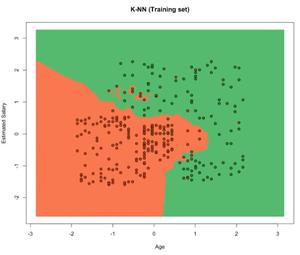R语言 使用k-Nearest Neighbors进行回归
机器学习是人工智能的一个子集,它为机器提供了自动学习的能力,无需明确编程。在这种情况下,机器在没有人类干预的情况下从经验中得到改善,并相应地调整行动。它主要有3种类型。
- 有监督的机器学习
- 无监督的机器学习
- 强化学习
K-最近的邻居
K-最近的邻居算法创建了一个假想的边界来对数据进行分类。当新的数据点被添加到预测中时,该算法将该点添加到离边界线最近的位置。它遵循 “物以类聚 ,人以群分 “的原则 。 这种算法可以很容易地在R语言中实现。
K-NN算法
- 选择K,邻居的数量。
- 计算K个邻居的欧几里得距离。
- 根据计算出的欧氏距离,取最近的K个邻居。
- 计算这K个邻居中每个类别的数据点的数量。
- 新的数据点被分配到邻居数量最多的类别中。
R语言 实现
数据集: 一个由400人组成的样本人口,与某产品公司分享他们的年龄、性别和工资,以及他们是否购买了该产品(0表示没有,1表示有)。下载数据集 Advertisement.csv
# Importing the dataset
dataset = read.csv('Advertisement.csv')
head(dataset, 10)
输出
| 编号 | 用户ID | 性别 | 年龄 | 估计工资 | 购买的 |
|---|---|---|---|---|---|
| 0 | 15624510 | 男性 | 19 | 19000 | 0 |
| 1 | 15810944 | 男性 | 35 | 20000 | 0 |
| 2 | 15668575 | 女性 | 26 | 43000 | 0 |
| 3 | 15603246 | 女性 | 27 | 57000 | 0 |
| 4 | 15804002 | 男性 | 19 | 76000 | 0 |
| 5 | 15728773 | 男性 | 27 | 58000 | 0 |
| 6 | 15598044 | 女性 | 27 | 84000 | 0 |
| 7 | 15694829 | 女性 | 32 | 150000 | 1 |
| 8 | 15600575 | 男 | 25 | 33000 | 0 |
| 9 | 15727311 | 女性 | 35 | 65000 | 0 |
# Encoding the target
# feature as factor
datasetPurchased = factor(datasetPurchased,
levels = c(0, 1))
# Splitting the dataset into
# the Training set and Test set
# install.packages('caTools')
library(caTools)
set.seed(123)
split = sample.split(dataset$Purchased,
SplitRatio = 0.75)
training_set = subset(dataset,
split == TRUE)
test_set = subset(dataset,
split == FALSE)
# Feature Scaling
training_set[-3] = scale(training_set[-3])
test_set[-3] = scale(test_set[-3])
# Fitting K-NN to the Training set
# and Predicting the Test set results
library(class)
y_pred = knn(train = training_set[, -3],
test = test_set[, -3],
cl = training_set[, 3],
k = 5,
prob = TRUE)
# Making the Confusion Matrix
cm = table(test_set[, 3], y_pred)
- 训练集包含300个条目。
- 测试集包含100个条目。
Confusion matrix result:
[[64][4]
[3][29]]
训练数据的可视化
# Visualising the Training set results
# Install ElemStatLearn if not present
# in the packages using(without hashtag)
# install.packages('ElemStatLearn')
library(ElemStatLearn)
set = training_set
#Building a grid of Age Column(X1)
# and Estimated Salary(X2) Column
X1 = seq(min(set[, 1]) - 1,
max(set[, 1]) + 1,
by = 0.01)
X2 = seq(min(set[, 2]) - 1,
max(set[, 2]) + 1,
by = 0.01)
grid_set = expand.grid(X1, X2)
# Give name to the columns of matrix
colnames(grid_set) = c('Age',
'EstimatedSalary')
# Predicting the values and plotting
# them to grid and labelling the axes
y_grid = knn(train = training_set[, -3],
test = grid_set,
cl = training_set[, 3],
k = 5)
plot(set[, -3],
main = 'K-NN (Training set)',
xlab = 'Age', ylab = 'Estimated Salary',
xlim = range(X1), ylim = range(X2))
contour(X1, X2, matrix(as.numeric(y_grid),
length(X1), length(X2)),
add = TRUE)
points(grid_set, pch = '.',
col = ifelse(y_grid == 1,
'springgreen3', 'tomato'))
points(set, pch = 21, bg = ifelse(set[, 3] == 1,
'green4', 'red3'))
输出

测试数据的可视化
# Visualising the Test set results
library(ElemStatLearn)
set = test_set
# Building a grid of Age Column(X1)
# and Estimated Salary(X2) Column
X1 = seq(min(set[, 1]) - 1,
max(set[, 1]) + 1,
by = 0.01)
X2 = seq(min(set[, 2]) - 1,
max(set[, 2]) + 1,
by = 0.01)
grid_set = expand.grid(X1, X2)
# Give name to the columns of matrix
colnames(grid_set) = c('Age',
'EstimatedSalary')
# Predicting the values and plotting
# them to grid and labelling the axes
y_grid = knn(train = training_set[, -3],
test = grid_set,
cl = training_set[, 3], k = 5)
plot(set[, -3],
main = 'K-NN (Test set)',
xlab = 'Age', ylab = 'Estimated Salary',
xlim = range(X1), ylim = range(X2))
contour(X1, X2, matrix(as.numeric(y_grid),
length(X1), length(X2)),
add = TRUE)
points(grid_set, pch = '.', col =
ifelse(y_grid == 1,
'springgreen3', 'tomato'))
points(set, pch = 21, bg =
ifelse(set[, 3] == 1,
'green4', 'red3'))
输出

优势
- 没有训练期。
- KNN是一种基于实例的学习算法,因此是一种懒惰的学习者。
- KNN不从训练表中得出任何判别函数,也没有训练期。
- KNN存储训练数据集并使用它来进行实时预测。
- 新的数据可以被无缝添加,并且不会影响算法的准确性,因为新添加的数据不需要训练。
- 实现KNN算法只需要两个参数,即K值和欧几里德距离函数。
缺点
- 在新的数据集中,计算每个现有点和新点之间的距离的成本是巨大的,这降低了算法的性能。
- 该算法很难计算每个维度的距离,因为该算法不能很好地处理高维数据,即具有大量特征的数据。
- 在将KNN算法应用于任何数据集之前,需要对特征进行缩放(标准化和规范化),否则KNN可能产生错误的预测。
- KNN对数据中的噪声很敏感。
 极客教程
极客教程